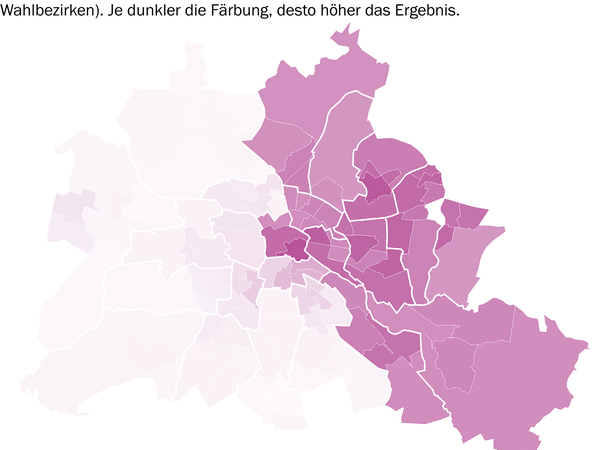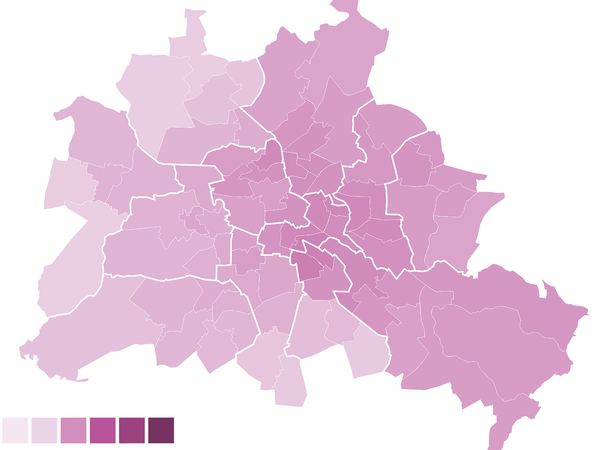The jubilation is followed by the hangover, which the Berlin left also had to experience in the night from Sunday to Monday. After the 6 p.m. forecast of 12.5 percent of the votes had been frenetically celebrated in the face of dismal results from other countries, a closer look at the results pours water into the wine.
The left lost 70,000 votes compared to the 2021 election, down 1.6 percentage points across Berlin. Others will decide whether to participate in government again and the acclaimed departure of the FDP can certainly not make up for the frustration on the left about the clear election victory of the CDU.
On the contrary, a trend that could already be observed in previous elections is continuing: More than 30 years after reunification, there is not much left of the party’s former strongholds in the east of the city.

While the party in Lichtenberg and Marzahn-Hellersdorf was by far the strongest force in 2016 and relegated the competition from the CDU, SPD and AfD to places, the balance of power has practically reversed itself in the past six and a half years. In Marzahn-Hellersdorf, the left ended up in 4th place behind the AfD and got less than half of the second votes from the CDU.

In Lichtenberg it was still enough for two direct mandates and second place behind the CDU. Across the district, however, the left lost 2.5 percentage points compared to 2021 and even 8.4 percentage points to 2016. The majority of votes for the left district mayor Michael Grunst was lost, as was that of his counterpart Sören Benn from Pankow.

It looks happier in parts of the city center. In the north of Friedrichshain, Damiano Valgolio defended the direct mandate he won in 2021 and even extended his lead over the much more prominent Green candidate Monika Herrmann.

In the Neukölln constituencies close to the city, the left-wing candidates Jorinde Schulz and Lucy Redler achieved top results with first vote results of 30.7 and 26.3 percent. In parts of Mitte, Kreuzberg and Schöneberg, too, the Left achieved respectable results with only minor losses or even slight gains.
We have to find answers to this by 2026.
Kristian Ronneburg, Left district leader in Marzahn-Hellersdorf
Is the left on the way to becoming an inner city party? From the point of view of Kristian Ronneburg, left district leader of Marzahn-Hellersdorf, things are more complicated. “The main reason for our poor performance is the inability of our own voters to mobilize,” he explains. Last but not least, the coalition and thus their own party are to blame.
“The constant argument, the constant harping, the channeling of resentment have clearly paid off for the CDU,” says Ronneburg. With a view to how the downward trend can be stopped in the once safe electoral districts, Ronneburg says: “An election campaign has to be conducted differently in milieus that are more anti-democratic and open to the right than in more left-wing milieus. We have to find answers to this by 2026.”
Ferat Kocak, who moved into the House of Representatives for the Neukölln left in 2021 and made it clear right from the start that he would rather go into the opposition than govern under Franziska Giffey, sees this course as confirmed by the election results in his district.
“Our anti-government policies are getting caught in Neukölln, they bring us a lot of encouragement. I think we should try to implement the Neukölln concept elsewhere,” explained Kocak. With a view to the debate about a new edition of the coalition, which would certainly come back to the left if the worst came to the worst, he said: “Government participation didn’t do us much good.”
And so, among other things, it is up to Party Vice Tobias Schulze to unite both poles and find answers to the question of how the outskirts in the east, which he calls the “Achilles heel”, can become the power center of the left again. An “offensive strategy is needed to reach people again,” says Schulze, describing it as a “question of survival for the entire left” to clarify what a modern left-socialist party offers. His suggestion: “A unifying concept, for example for functioning public transport or administration, that appeals to both groups.”
To home page

